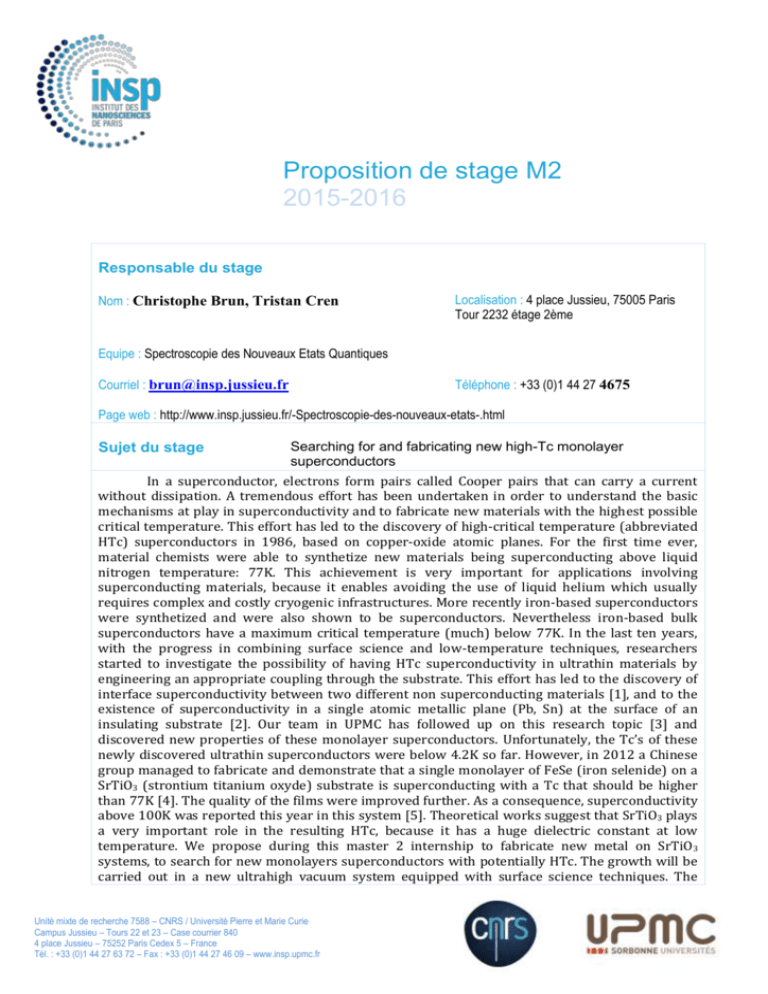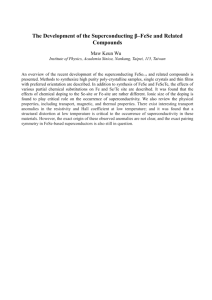Proposition de stage M2 2015-2016 Responsable du stage Nom
advertisement

Proposition de stage M2 2015-2016 Responsable du stage Nom : Christophe Brun, Tristan Cren Localisation : 4 place Jussieu, 75005 Paris Tour 2232 étage 2ème Equipe : Spectroscopie des Nouveaux Etats Quantiques Courriel : brun@insp.jussieu.fr Téléphone : +33 (0)1 44 27 4675 Page web : http://www.insp.jussieu.fr/-Spectroscopie-des-nouveaux-etats-.html Searching for and fabricating new high-Tc monolayer superconductors In a superconductor, electrons form pairs called Cooper pairs that can carry a current without dissipation. A tremendous effort has been undertaken in order to understand the basic mechanisms at play in superconductivity and to fabricate new materials with the highest possible critical temperature. This effort has led to the discovery of high-critical temperature (abbreviated HTc) superconductors in 1986, based on copper-oxide atomic planes. For the first time ever, material chemists were able to synthetize new materials being superconducting above liquid nitrogen temperature: 77K. This achievement is very important for applications involving superconducting materials, because it enables avoiding the use of liquid helium which usually requires complex and costly cryogenic infrastructures. More recently iron-based superconductors were synthetized and were also shown to be superconductors. Nevertheless iron-based bulk superconductors have a maximum critical temperature (much) below 77K. In the last ten years, with the progress in combining surface science and low-temperature techniques, researchers started to investigate the possibility of having HTc superconductivity in ultrathin materials by engineering an appropriate coupling through the substrate. This effort has led to the discovery of interface superconductivity between two different non superconducting materials [1], and to the existence of superconductivity in a single atomic metallic plane (Pb, Sn) at the surface of an insulating substrate [2]. Our team in UPMC has followed up on this research topic [3] and discovered new properties of these monolayer superconductors. Unfortunately, the Tc’s of these newly discovered ultrathin superconductors were below 4.2K so far. However, in 2012 a Chinese group managed to fabricate and demonstrate that a single monolayer of FeSe (iron selenide) on a SrTiO3 (strontium titanium oxyde) substrate is superconducting with a Tc that should be higher than 77K [4]. The quality of the films were improved further. As a consequence, superconductivity above 100K was reported this year in this system [5]. Theoretical works suggest that SrTiO3 plays a very important role in the resulting HTc, because it has a huge dielectric constant at low temperature. We propose during this master 2 internship to fabricate new metal on SrTiO3 systems, to search for new monolayers superconductors with potentially HTc. The growth will be carried out in a new ultrahigh vacuum system equipped with surface science techniques. The Sujet du stage Unité mixte de recherche 7588 – CNRS / Université Pierre et Marie Curie Campus Jussieu – Tours 22 et 23 – Case courrier 840 4 place Jussieu – 75252 Paris Cedex 5 – France Tél. : +33 (0)1 44 27 63 72 – Fax : +33 (0)1 44 27 46 09 – www.insp.upmc.fr newly synthetized films will be further studied by scanning tunneling microscopy/spectroscopy (STM / STS) at very low temperature (300 mK) and high field (10 T), to investigate the superconducting properties with a state-of-the-art experimental set-up unique in France and having only few equivalent in the world. [1] Reyren, N. et al. Science 317, 1196 (2007); [2] Zhang, T. et al. Nature Phys. 6, 104 (2010); [3] C. Brun, T. Cren et al. Nature Physics 10, 444 (2014); [4] Q.Y Wang et al. 29, 037402 Chin. Phys. Lett. (2012); [5] J.F. Ge et al. Nature Materials 14, 285 (2015); Techniques utilisées : ultrahigh vacuum techniques, molecular beam epitaxy, low-energy- electron diffraction, Auger spectroscopy, scanning tunneling microscopy/spectroscopy, very low temperature, magnetic field, data analysis and modelling. Stage rémunéré : 480 euros/mois Ce stage pourra t-il se poursuivre en thèse : oui Si oui, financement envisagé : bourse de l’école doctorale Unité mixte de recherche 7588 – CNRS / Université Pierre et Marie Curie Campus Jussieu – Tours 22 et 23 – Case courrier 840 4 place Jussieu – 75252 Paris Cedex 5 – France Tél. : +33 (0)1 44 27 63 72 – Fax : +33 (0)1 44 27 46 09 – www.insp.upmc.fr











